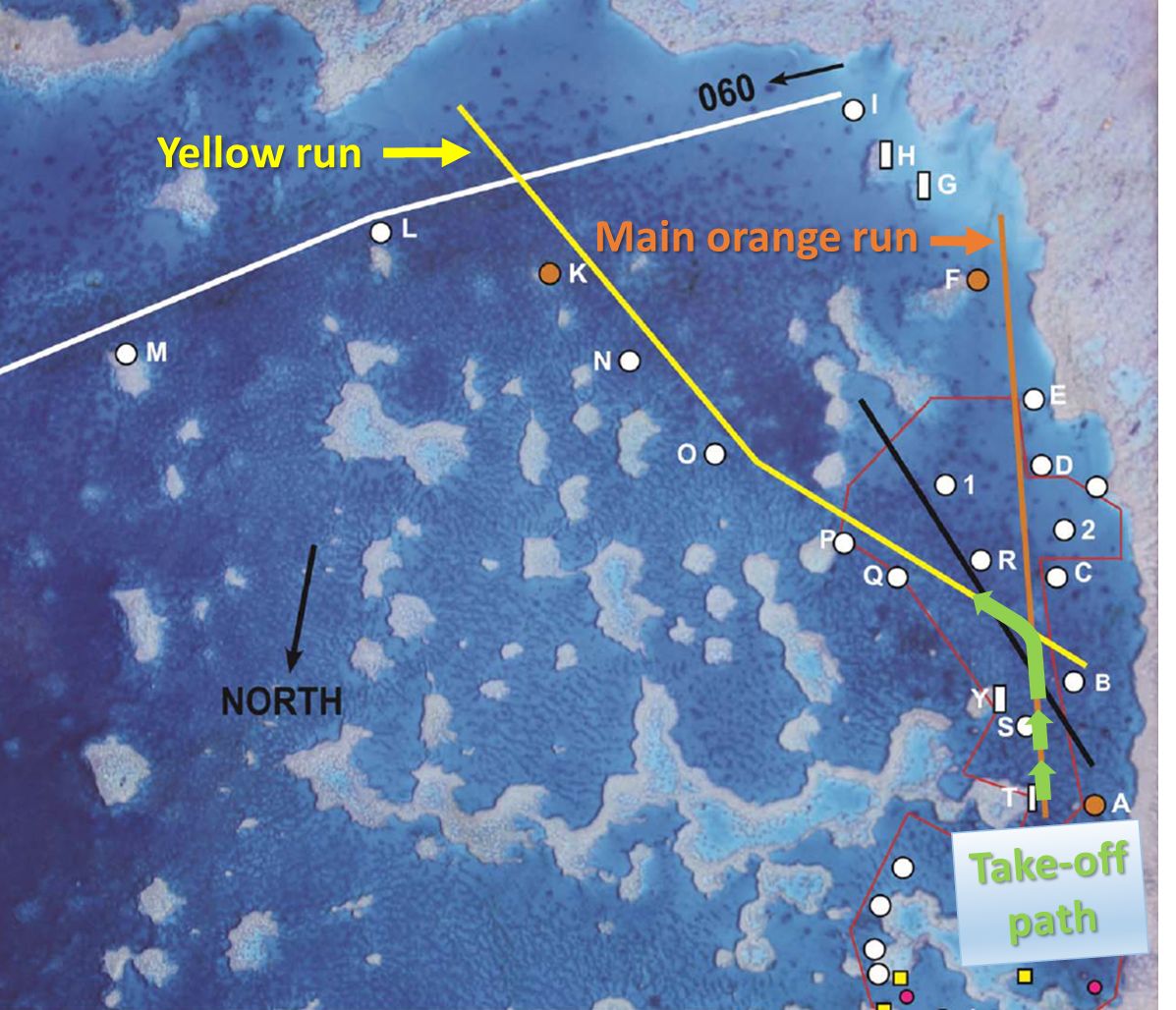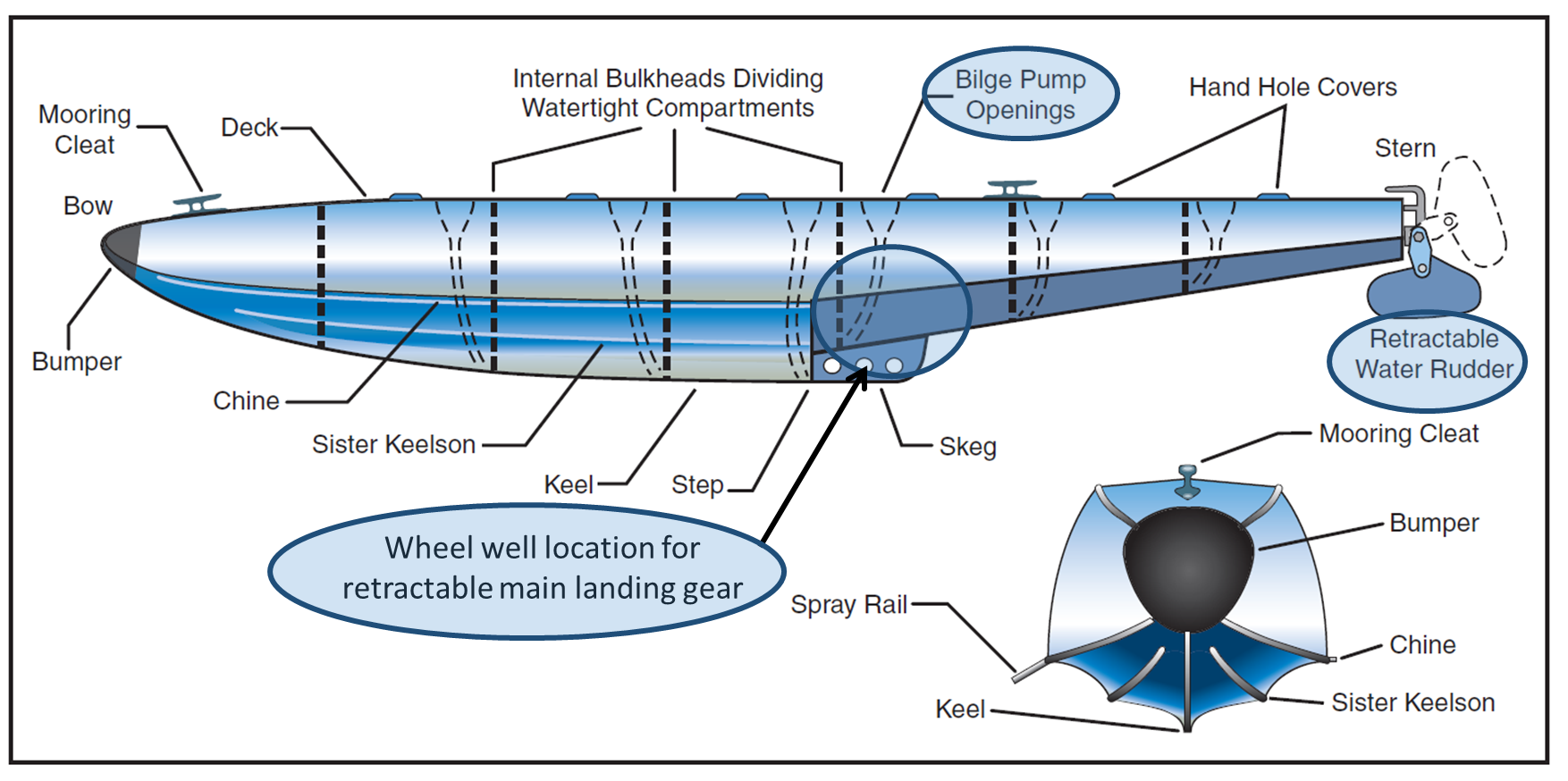What happened
On 25 June 2015, at about 1111 Eastern Standard Time (EST), a de Havilland Canada DHC-2 amphibian[1] aircraft, registered VH-AWI (AWI), taxied at Hardy Lagoon aircraft landing area (ALA), Queensland, for a flight to Shute Harbour with the pilot and seven passengers on board.
The Hardy Lagoon ALA had marker buoys to identify the location of the bommies[2] that were near each of the four take-off and landing areas. The main take-off run (orange run) to the south, started at buoy A, and continued onto buoys B, C, D, E, F (Figure 1, orange line). The take-off run to the east-south-east (yellow run), started at buoy B, and continued onto buoys Q, P, O, N, K (Figure 1, yellow line). As per company policy, the pilot elected to start the take-off at buoy A on the orange run and then turn onto the yellow run. This combination of take-off runs allowed the pilot the maximum take-off distance, for the aircraft’s take-off weight.
Figure 1: Hardy lagoon aircraft landing area.

Source: Aircraft operator, modified by the ATSB
The pilot taxied AWI to buoy A and lined up on the orange run. They then advanced the throttle slowly to commence the take-off. As AWI approached buoy B the engine was not at full power. The pilot commenced the turn onto the yellow run utilising the water rudders,[3] which were in the down position. Coming out of the turn the pilot retracted the water rudders and applied right rudder to stop the turn and line up on the yellow run.
The pilot looked inside the cockpit to check the engine instrumentation and to see if the engine had reached full power. At this stage, the aircraft had not risen onto the step[4] (Figure 2). When the pilot looked outside again, they noticed that the nose of the aircraft had drifted too far to the left. The nose had lined up on the left side of the buoy Q, which marked the location of the Q bommie. The pilot attempted to apply more right rudder, but had already applied full right rudder. AWI then hit and passed over the Q coral reef bommie and the pilot closed the engine throttle. AWI continued moving forward and the pilot shut down the engine and lowered the flaps to help slow the aircraft. The left front float slid onto the P bommie and the aircraft came to a stop.
The pilot exited the aircraft and pushed the aircraft off the bommie, before re-entering the cockpit. When AWI had drifted far enough away from the bommie, the pilot restarted the engine and taxied the aircraft to a nearby moored boat, where the passengers disembarked.
The pilot and seven passengers were uninjured and the aircraft sustained minor damage (Figure 3).
Figure 2: AWI conducting a water take-off (not the occurrence take-off). Note the high nose attitude, skids sitting up out of the water as the aircraft is ploughing through the water. AWI has not gained enough speed in the take-off to reach the step, where the nose would be lower and the aircraft would glide along the water on the floats.

Source: Aircraft operator, modified by the ATSB
Figure 3: Damage to AWI floats included two holes on the bottom side of each float compartment immediately forward of the wheel well.

Source: Aircraft operator
Attempt to reposition the aircraft
After consultation with the chief pilot, who was also at Hardy Lagoon, the pilot attempted a second take-off on the orange run, without any passengers on board. The pilot aborted the take-off at about buoy E, as the aircraft would normally be on the step at this point. The pilot taxied back to the moored boat, shut the aircraft down, and then pumped out water from the compartments in the floats (Figure 4). They then attempted another take-off on the orange run, again without success.
Figure 4: Example cross-section view of the float compartments. Note the bilge pump openings to remove water from the float compartments during the pre-flight inspection, the retractable water rudder used for directional control while taxiing and the location of the wheel well for the retractable main landing gear.

Source: Federal Aviation Administration, modified by the ATSB
Pilot comment
The pilot decided to use a combination of the orange and yellow run to give the maximum take-off distance. The pilot indicated that they did this because the aircraft was close to the maximum take-off weight and it was approaching low tide, so the coral reef bommies were more exposed.
The pilot reported a gentle breeze of about 8 kt from south-east and the water was smooth with small ripples. The wind direction was between the orange and yellow runs.
The pilot indicated that they did not advance the throttle as quickly as they would normally, due to a recent conversation with other another company pilot. The conversation was about managing the aircraft engine to ensure that the engine limits were not exceeded. In retrospect, the pilot thought that for the occurrence flight, the advancement of the throttle was too slow. Normally turning onto the yellow run the engine would be at full power.
Pilot experience
The pilot had a total time of about 904 hours, with 540 hours on the DHC-2 aircraft. Of their total time about 595 hours was on seaplanes, with 941 water landings and take-offs. The pilot had 34 landings at the Hardy Lagoon ALA, including 21 solo landings, and 13 under supervision. The pilot had last landed at the Hardy Lagoon ALA 32 days prior to the occurrence.
Operator comment
In light winds, where the pilot wanted additional take-off length, it was standard company procedure to start the take-off on the orange run and then to turn onto the yellow run. The aircraft had a payload of 440 kg, 10 kg under the company limit weight for the aircraft for take- off.
The chief pilot reported that the pilot had pumped out all the water from the floats prior to taxi on the occurrence flight.
Safety action
Whether or not the ATSB identifies safety issues in the course of an investigation, relevant organisations may proactively initiate safety action in order to reduce their safety risk. The ATSB has been advised of the following proactive safety action in response to this occurrence.
Aircraft operator
As a result of this occurrence, the aircraft operator has advised the ATSB that all company pilots will be made aware of the serious incident and conduct recurrent training on the Hardy Lagoon ALA.
Safety message
This serious incident illustrates that distractions can have a significant impact on flight safety. Distraction is a process, condition, or activity that takes a pilot’s attention away from the task of flying. Even a momentary deflection of attention away from the primary task can have adverse consequences.
The Federal Aviation Administration published a handbook Seaplane, skiplane, and float/ski equipped helicopter operations handbook, for pilots and is available from the FAA website. The handbook discuss the importance of the pilot planning an effective course of action, and mentally staying ahead of the seaplane.
The serious incident highlights the importance of pre-flight decision making and planning for emergencies and abnormal situations for the particular aerodrome. A thorough pre-flight self-brief covering the different emergency scenarios may help to minimise safety critical decisions during a high workload situation such as a take-off.
Aviation Short Investigations Bulletin - Issue 47
Purpose of safety investigationsThe objective of a safety investigation is to enhance transport safety. This is done through:
It is not a function of the ATSB to apportion blame or provide a means for determining liability. At the same time, an investigation report must include factual material of sufficient weight to support the analysis and findings. At all times the ATSB endeavours to balance the use of material that could imply adverse comment with the need to properly explain what happened, and why, in a fair and unbiased manner. The ATSB does not investigate for the purpose of taking administrative, regulatory or criminal action. TerminologyAn explanation of terminology used in ATSB investigation reports is available here. This includes terms such as occurrence, contributing factor, other factor that increased risk, and safety issue. Publishing informationReleased in accordance with section 25 of the Transport Safety Investigation Act 2003 Published by: Australian Transport Safety Bureau © Commonwealth of Australia 2016
Ownership of intellectual property rights in this publication Unless otherwise noted, copyright (and any other intellectual property rights, if any) in this report publication is owned by the Commonwealth of Australia. Creative Commons licence With the exception of the Coat of Arms, ATSB logo, and photos and graphics in which a third party holds copyright, this publication is licensed under a Creative Commons Attribution 3.0 Australia licence. Creative Commons Attribution 3.0 Australia Licence is a standard form licence agreement that allows you to copy, distribute, transmit and adapt this publication provided that you attribute the work. The ATSB’s preference is that you attribute this publication (and any material sourced from it) using the following wording: Source: Australian Transport Safety Bureau Copyright in material obtained from other agencies, private individuals or organisations, belongs to those agencies, individuals or organisations. Where you wish to use their material, you will need to contact them directly. |
__________
- An aircraft with floats to land on water and retractable wheel-type landing gear that can be extended to allow landing on land. The floats are part of the aircraft landing gear that provide the buoyancy to keep the aircraft afloat
- Bommie is a slang name for bombora, an Australian term for an area of large sea waves breaking over a shallow area such as a submerged rock shelf, reef, or sand bank that is located some distance from the shoreline and beach surf break.
- Water rudders are retractable control surfaces on the back of each float that can be extended downward into the water to provide directional control when taxiing on the surface. They are attached by cables and springs to the air rudder and operated by the rudder pedals in the cockpit.
- The step position is the attitude of the aircraft when the entire weight of the aircraft is supported by hydrodynamic and aerodynamic lift, as it is during high-speed taxi or just prior to take off. This position produces the least amount of water drag. The step is also called the planing position.


